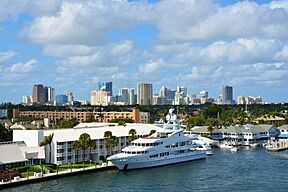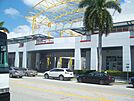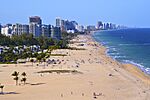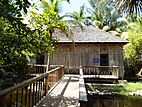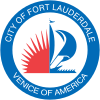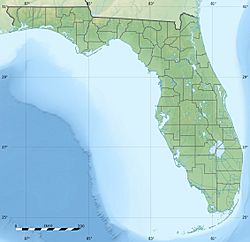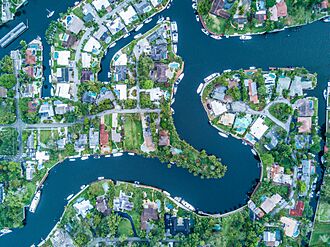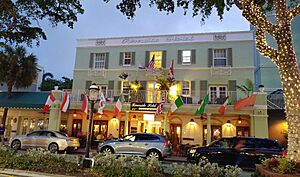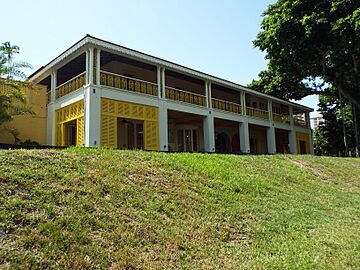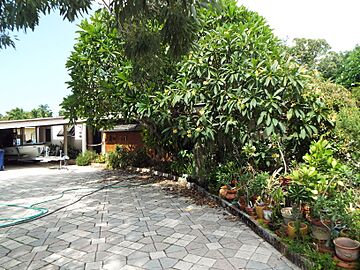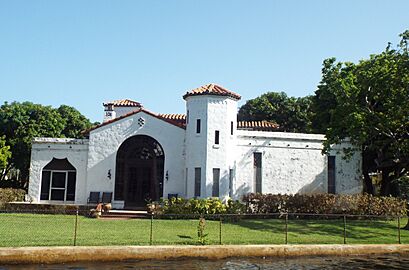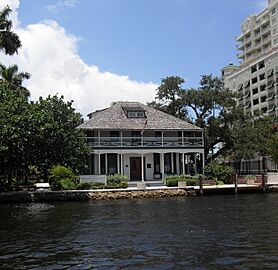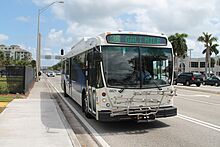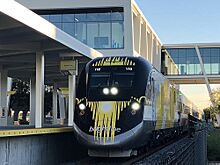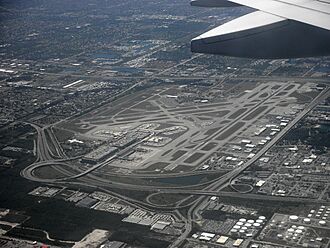Fort Lauderdale, Florida facts for kids
Quick facts for kids
Fort Lauderdale
|
|||
|---|---|---|---|
|
|
|||
|
|||
| Nickname(s):
Venice of America
|
|||
| Country | United States | ||
| State | Florida | ||
| County | Broward | ||
| Established | March 27, 1911 | ||
| Named for | William Lauderdale | ||
| Government | |||
| • Type | Commission-Manager | ||
| Area | |||
| • Total | 36.30 sq mi (94.01 km2) | ||
| • Land | 34.59 sq mi (89.58 km2) | ||
| • Water | 1.71 sq mi (4.44 km2) 4.71% | ||
| Elevation | 9 ft (2.75 m) | ||
| Population
(2020)
|
|||
| • Total | 182,760 | ||
| • Estimate
(2022)
|
183,146 | ||
| • Rank | 140th in the United States 10th in Florida |
||
| • Density | 5,284.07/sq mi (2,040.21/km2) | ||
| Time zone | UTC−5 (Eastern (EST)) | ||
| • Summer (DST) | UTC−4 (EDT) | ||
| ZIP Codes |
33301–33332, 33334-33340, 33345–33346, 33348–33349, 33351, 33355, 33359, 33388, 33394
|
||
| Area codes | 754, 954 | ||
| FIPS code | 12-24000 | ||
| GNIS feature ID | 0282693 | ||
| Primary Airport | Fort Lauderdale-Hollywood International Airport | ||
Fort Lauderdale is a city on the coast of Florida, in the United States. It is about 30 miles (48 km) north of Miami, right on the Atlantic Ocean. It is the main city in Broward County and has the most people there.
In 2020, about 182,760 people lived in Fort Lauderdale. This makes it the tenth-largest city in Florida. It is also the third-largest city in the Miami metropolitan area.
The city was first built in 1838 and became an official city in 1911. It is named after forts built by the United States during the Second Seminole War. These forts were named after Major William Lauderdale. The city started to grow about 50 years after these forts were no longer used.
Fort Lauderdale is often called the "Venice of America." This is because it has 165 miles (266 km) of waterways inside the city. Besides tourism, Fort Lauderdale has many different types of businesses. These include marine industries, manufacturing, finance, and technology.
The city is a very popular place for tourists. It has warm weather all year, with an average temperature of 75.5°F (24.2°C). It also gets about 3,000 hours of sunshine each year. In 2018, over 13 million people visited the greater Fort Lauderdale area. Nearly four million cruise passengers use Port Everglades each year. This makes it the third-largest cruise port in the world. Fort Lauderdale is also known as the "yachting capital of the world." It has over 50,000 registered yachts and 100 marinas.
Contents
History
The land where Fort Lauderdale now stands was home to the Tequesta Indians for over 2,000 years. When Spanish explorers arrived in the 1500s, they brought diseases like smallpox. The Tequesta people had no protection against these illnesses. This, along with fights with their neighbors, caused their numbers to drop. By 1763, most of the remaining Tequesta moved to Cuba.
The area was known as the "New River Settlement" before the 1900s. In the 1830s, about 70 settlers lived along the New River. In 1836, a group of Seminoles attacked a farm. This caused all the white settlers to leave the area.
The first Fort Lauderdale was built in 1838 during the Second Seminole War. The fort was left empty in 1842 after the war ended. The area stayed mostly empty until the 1890s. Growth began when Frank Stranahan started a ferry service in 1893. The Florida East Coast Railroad also built a route through the area in 1896. The city officially became a city in 1911. In 1915, it became the main city for the new Broward County.
Fort Lauderdale started to grow a lot in the 1920s. However, the 1926 Miami hurricane and the Great Depression in the 1930s caused economic problems. During World War II, Fort Lauderdale became an important U.S. military base. It had a Naval Air Station for training pilots and a Coast Guard base.
For a long time, only white people were allowed on Fort Lauderdale beaches. In 1954, a beach for African-Americans opened in Dania Beach. However, there was no road to it until 1965. In 1961, African Americans began protests to use all beaches. In 1962, a court decision ended racial segregation on Broward County beaches.
Today, Fort Lauderdale is a major center for yachts. It is also one of the biggest tourist spots in the country. It is the center of a large area with 1.8 million people.
Population Growth
After World War II, many service members came back to the area. This caused a huge increase in population. In 1960, the city had 83,648 people. This was about 230% more than in 1950. By 1970, the population reached 139,590.
After 1970, many people started moving to the suburbs west of the city. Fort Lauderdale's population grew slowly. It even got smaller by almost 4,000 people between 1980 and 1990. In 1990, the population was 149,377.
The population grew a little to 152,397 by 2000. Since 2000, Fort Lauderdale has gained over 18,000 residents. This happened because the city added seven nearby neighborhoods. By 2020, the population reached 182,760.
Geography
Location and Waterways
Fort Lauderdale covers about 38.6 square miles (99.9 km2). Most of this is land, but about 3.8 square miles (9.9 km2) is water. The city is famous for its many canals. There are 165 miles (266 km) of waterways within the city limits.
The city is next to the Atlantic Ocean and has 7 miles (11 km) of beaches. It shares borders with several other cities:
- To its east: Lauderdale-by-the-Sea and Sea Ranch Lakes.
- To its south: Hollywood and Dania Beach.
- To its southwest: Davie.
- To its west: Plantation, Lauderhill, and Lauderdale Lakes.
- To its northwest: North Lauderdale, Oakland Park, and Tamarac.
- To its north: Wilton Manors and Pompano Beach.
Off the coast of Fort Lauderdale is the Osborne Reef. This is an artificial reef made of old tires. It was meant to help fish, but it became an environmental problem. The tires broke free and damaged a natural reef. Thousands of tires have also washed up on beaches. Now, efforts are being made to remove these tires.
Neighborhoods
Fort Lauderdale has a program to officially recognize its neighborhoods. More than 60 neighborhoods have been officially recognized by the city. There are also many other neighborhoods that are not officially recognized.
Climate and Weather
Fort Lauderdale has a tropical rainforest climate. This means it is warm and wet most of the year. The wet season is from May to October. During this time, it is hot, humid, and rainy. High temperatures are usually between 86°F and 90°F (30-32°C). Lows are between 73°F and 78°F (23-26°C). More than half of summer days have short thunderstorms. The highest temperature ever recorded was 100°F (38°C).
The dry season is from November to April. The weather is usually warm, dry, and sunny. High temperatures are typically between 75°F and 83°F (24-28°C). Lows are between 60°F and 70°F (16-21°C). Sometimes, it can get cooler, with highs in the 60s°F (16-21°C) and lows in the 40s°F (4-10°C). Snow is very rare; it has only been reported once in 1977. During the dry season, brush fires can be a concern.
Fort Lauderdale gets about 60.95 inches (1548 mm) of rain each year. Most of this rain falls during the wet season. However, it can rain in any month. For example, in April 2023, about two feet of rain fell in half a day, causing big floods. The Atlantic hurricane season is from June 1 to November 30. Major hurricanes are most likely in September and October.
| Climate data for Fort Lauderdale–Hollywood International Airport, Florida (1991–2020 normals, extremes 1912–present) | |||||||||||||
|---|---|---|---|---|---|---|---|---|---|---|---|---|---|
| Month | Jan | Feb | Mar | Apr | May | Jun | Jul | Aug | Sep | Oct | Nov | Dec | Year |
| Record high °F (°C) | 92 (33) |
94 (34) |
94 (34) |
96 (36) |
99 (37) |
100 (38) |
99 (37) |
100 (38) |
99 (37) |
95 (35) |
91 (33) |
90 (32) |
100 (38) |
| Mean maximum °F (°C) | 83.8 (28.8) |
85.7 (29.8) |
88.4 (31.3) |
90.2 (32.3) |
91.7 (33.2) |
93.6 (34.2) |
94.0 (34.4) |
93.6 (34.2) |
92.6 (33.7) |
90.7 (32.6) |
86.4 (30.2) |
84.6 (29.2) |
95.0 (35.0) |
| Mean daily maximum °F (°C) | 75.6 (24.2) |
77.4 (25.2) |
79.7 (26.5) |
82.9 (28.3) |
85.8 (29.9) |
88.4 (31.3) |
90.0 (32.2) |
90.0 (32.2) |
88.3 (31.3) |
85.4 (29.7) |
80.8 (27.1) |
77.7 (25.4) |
83.5 (28.6) |
| Daily mean °F (°C) | 68.3 (20.2) |
70.3 (21.3) |
72.6 (22.6) |
76.4 (24.7) |
79.7 (26.5) |
82.5 (28.1) |
83.8 (28.8) |
84.0 (28.9) |
82.7 (28.2) |
79.9 (26.6) |
74.6 (23.7) |
71.2 (21.8) |
77.2 (25.1) |
| Mean daily minimum °F (°C) | 60.9 (16.1) |
63.3 (17.4) |
65.6 (18.7) |
69.9 (21.1) |
73.5 (23.1) |
76.6 (24.8) |
77.6 (25.3) |
77.9 (25.5) |
77.1 (25.1) |
74.4 (23.6) |
68.3 (20.2) |
64.7 (18.2) |
70.8 (21.6) |
| Mean minimum °F (°C) | 43.1 (6.2) |
47.0 (8.3) |
50.8 (10.4) |
58.3 (14.6) |
65.8 (18.8) |
71.0 (21.7) |
72.3 (22.4) |
72.6 (22.6) |
72.3 (22.4) |
63.8 (17.7) |
54.3 (12.4) |
48.1 (8.9) |
40.7 (4.8) |
| Record low °F (°C) | 28 (−2) |
28 (−2) |
32 (0) |
40 (4) |
49 (9) |
57 (14) |
64 (18) |
66 (19) |
61 (16) |
46 (8) |
35 (2) |
29 (−2) |
28 (−2) |
| Average precipitation inches (mm) | 2.90 (74) |
2.38 (60) |
2.38 (60) |
3.02 (77) |
5.56 (141) |
9.55 (243) |
5.41 (137) |
7.89 (200) |
8.02 (204) |
7.37 (187) |
3.69 (94) |
2.78 (71) |
60.95 (1,548) |
| Average precipitation days (≥ 0.01 in) | 7.0 | 5.9 | 6.3 | 6.6 | 10.4 | 16.0 | 15.7 | 17.0 | 16.1 | 12.2 | 9.6 | 8.4 | 131.2 |
| Source: NOAA | |||||||||||||
People and Demographics
| Historical population | |||
|---|---|---|---|
| Census | Pop. | %± | |
| 1920 | 2,065 | — | |
| 1930 | 8,666 | 319.7% | |
| 1940 | 17,996 | 107.7% | |
| 1950 | 36,328 | 101.9% | |
| 1960 | 83,648 | 130.3% | |
| 1970 | 139,590 | 66.9% | |
| 1980 | 153,279 | 9.8% | |
| 1990 | 149,377 | −2.5% | |
| 2000 | 152,397 | 2.0% | |
| 2010 | 165,521 | 8.6% | |
| 2020 | 182,760 | 10.4% | |
| 2022 (est.) | 183,146 | 10.6% | |
| U.S. Decennial Census 1920–1970 1980 1990 2000 2010 2020 2022 |
|||
Fort Lauderdale is the second-largest city in the Miami metropolitan area. It is the largest city in Broward County. Its population grew very quickly in the first 70 years of the 1900s. In 1900, only 91 people lived there. By 1970, the population was 139,590.
After 1970, the city's growth slowed down. In the 1980s, the population actually decreased for the first time. By 1990, it was just under 150,000 people. The population grew a little again by 2000, reaching 152,397.
In the 2000s, the population started to grow much more. By 2010, it reached 165,521. By 2020, the population was 182,760.
| Historical demographics | 2020 | 2010 | 2000 | 1990 | 1980 |
|---|---|---|---|---|---|
| White (non-Hispanic) | 47.5% | 52.5% | 57.5% | 64.5% | 74.5% |
| Black or African American (non-Hispanic) | 27.1% | 30.4% | 28.5% | 27.3% | 20.5% |
| Hispanic or Latino | 19.2% | 13.7% | 9.5% | 7.2% | 4.2% |
| Asian (non-Hispanic) | 2.0% | 1.5% | 1.0% | 0.8% | 0.8% |
| Native American (non-Hispanic) | 0.2% | 0.2% | 0.2% | 0.2% | |
| Some other race (non-Hispanic) | 0.7% | 0.3% | 0.2% | 0.1% | |
| Two or more races (non-Hispanic) | 3.3% | 1.4% | 3.2% | N/A | N/A |
| Population | 182,760 | 165,521 | 152,397 | 149,377 | 153,279 |
| Demographic characteristics | 2020 | 2010 | 2000 | 1990 | 1980 |
|---|---|---|---|---|---|
| Households | 103,140 | 93,159 | 80,862 | 66,440 | 67,623 |
| People per household | 1.77 | 1.78 | 1.88 | 2.25 | 2.27 |
| Males per 100 females | 109.7 | 111.8 | 110.0 | 101.7 | 92.5 |
| Ages 0–17 | 16.2% | 17.6% | 19.4% | 18.8% | 19.3% |
| Ages 18–64 | 64.6% | 67.1% | 65.3% | 63.4% | 61.6% |
| Ages 65 + | 19.2% | 15.3% | 15.3% | 17.8% | 19.1% |
| Median age | 43.9 | 42.2 | 39.3 | 37.1 | 36.3 |
| Population | 182,760 | 165,521 | 152,397 | 149,377 | 153,279 |
| Economic indicators | |||
|---|---|---|---|
| 2017–21 American Community Survey | Fort Lauderdale | Broward County | Florida |
| Median income | $38,304 | $36,222 | $34,367 |
| Median household income | $66,994 | $64,522 | $61,777 |
| Poverty Rate | 15.4% | 12.4% | 13.1% |
| High school diploma or higher (25+ years old) | 89.1% | 90.0% | 89.0% |
| Bachelor's degree or higher (25+ years old) | 39.3% | 34.3% | 31.5% |
| Advanced degree (25+ years old) | 15.5% | 13.1% | 11.7% |
| Language spoken at home | 2015 | 2010 | 2000 | 1990 | 1980 |
|---|---|---|---|---|---|
| English | 71.4% | 74.0% | 75.1% | 80.7% | 90.3% |
| Spanish or Spanish Creole | 15.9% | 13.0% | 9.4% | 6.8% | 3.6% |
| French or Haitian Creole | 6.9% | 7.4% | 9.6% | 7.6% | 1.6% |
| Other languages | 5.8% | 5.6% | 5.9% | 4.9% | 4.5% |
| Nativity | 2015 | 2010 | 2000 | 1990 | 1980 |
|---|---|---|---|---|---|
| % population born in the US | 76.2% | 78.1% | 78.3% | 82.6% | 90.1% |
| ... born in the United States | 73.7% | 75.7% | 76.4% | 80.8% | 89.0% |
| ... born in Puerto Rico or Island Areas | 1.5% | 1.5% | 1.1% | 0.9% | 1.1% |
| ... born to American parents abroad | 1.0% | 0.9% | 0.8% | 0.9% | |
| % population foreign-born | 23.8% | 21.9% | 21.7% | 17.4% | 9.9% |
| ... born in Haiti | 4.6% | 4.1% | 5.8% | 4.3% | N/A |
| ... born in Jamaica | 2.3% | 2.0% | 1.7% | 1.1% | 0.7% |
| ... born in Cuba | 1.6% | 1.8% | 1.3% | 1.2% | 0.9% |
| ... born in other countries | 15.3% | 14.0% | 12.9% | 10.8% | 8.3% |
In 2010, about 52.5% of Fort Lauderdale's population was of European background (non-Hispanic white). About 31.0% were of African background. About 13.7% were of Hispanic or Latino background. About 1.5% were of Asian background.
Fort Lauderdale, along with nearby cities like Oakland Park and Wilton Manors, is known for its large LGBT community. It is a popular vacation spot for gay and lesbian people. The city has many hotels and guesthouses that welcome LGBT visitors. The Stonewall Library & Archives is in Fort Lauderdale. In Wilton Manors, there is the Pride Center, a large LGBT community center. The current mayor of Fort Lauderdale, Dean Trantalis, is the first openly gay person to hold this job.
Economy
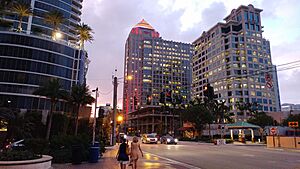
Fort Lauderdale's economy has changed over time. From the 1940s to the 1980s, it was famous as a spring break spot for college students. However, the city has since made rules to discourage large student crowds. Now, Fort Lauderdale attracts wealthier tourists.
Cruise ships and boating activities bring in a lot of money from tourism. There is a large convention center near the beach. It has 600,000 square feet (55,742 m2) of space. About 30% of the city's 10 million yearly visitors come for conventions.
The downtown area, especially around Las Olas Boulevard, has been redeveloped since 2002. It now has many new hotels and tall apartment buildings. The city's downtown is the biggest business area in Broward County. It has many office buildings and high-rises.
Fort Lauderdale is a major place for building and fixing yachts. The boating industry creates over 109,000 jobs in the county. With its many canals and closeness to the Bahamas and Caribbean, it is a popular place for yachting vacations. It is home to 42,000 boats and about 100 marinas. The yearly Fort Lauderdale International Boat Show is the world's largest boat show. It brings over 125,000 people to the city each year.
Top Employers
Here are some of the biggest employers in Fort Lauderdale, according to a 2020 report:
| Employer | Employees |
|---|---|
| AutoNation | 3,000 |
| Citrix | 1,700 |
| Kaplan | 1,291 |
| Rick Case Automotive Group | 905 |
| Sun-Sentinel | 897 |
Arts and Culture
Like many parts of Florida, Fort Lauderdale's population changes with the seasons. Many "snowbirds" from colder places spend winter and spring here. The city is known for its beaches, restaurants, and nightlife. It used to be a huge spring break spot in the 1960s and 1970s. However, the city has made rules to prevent the wild behavior that happened back then. Since the 1990s, Fort Lauderdale has focused on attracting people looking for a resort lifestyle. It hosts many professional events, concerts, and art shows.
Fort Lauderdale's arts and entertainment area is called the Riverwalk Arts & Entertainment District. It stretches along Las Olas Boulevard. This area has the Broward Center for the Performing Arts and the Museum of Discovery and Science. The city and its suburbs have over 4,100 restaurants and more than 120 nightclubs. Many of these are in the arts district. The city is also where the 1986 movie Flight of the Navigator was filmed. It also hosts Langerado, an annual music festival. In 2013, the county welcomed about 1.3 million LGBT travelers. They spent about $1.5 billion in the area.
Film Festival
The Fort Lauderdale International Film Festival has been held every year since 1986.
Places to Visit

Hugh Taylor Birch State Park is a 180-acre (0.73 km2) park along the beach. It has nature trails, camping, and picnic areas. You can also go canoeing there. The park has a visitor center with exhibits about its ecosystem. The Bonnet House is a historic home in Fort Lauderdale. It was built in 1895. The property was given as a wedding gift in 1919. It is now listed on the National Register of Historic Places.
The Henry E. Kinney Tunnel on U.S. Route 1 is the only tunnel on a state road in Florida. It was built in 1960. It goes under the New River and Las Olas Boulevard.
The Riverwalk Arts and Entertainment District in downtown Fort Lauderdale has many attractions. These include the Broward Center for the Performing Arts and the Museum of Discovery and Science. It also has the Florida Grand Opera, Fort Lauderdale Historical Center, and the Riverside Hotel. The Museum of Art is also in this district.
Las Olas Boulevard is a popular street in downtown Fort Lauderdale. It goes from the business district to Fort Lauderdale Beach. It is a favorite spot for both locals and visitors. It is known for its unique shops and restaurants.
Besides its museums, beaches, and nightlife, Fort Lauderdale has other interesting places. The Fort Lauderdale Swap Shop is a large flea market. It also has the world's largest drive-in movie theater with 13 screens. North Woodlawn Cemetery, an African-American cemetery, is also a historic site. Calvary Chapel Fort Lauderdale is a large church. The annual Fort Lauderdale International Boat Show displays hundreds of boats and yachts.
Historic Buildings
Here are some historic buildings in Fort Lauderdale. Some of them are listed on the National Register of Historic Places:
- Fort Lauderdale, Florida
-
The Dr. Willard Van Orsdel King House was built in 1951. It was listed in the National Register of Historic Places in 2006.
-
Stranahan House, the oldest building in Fort Lauderdale. It was first a trading post.
Sports
Lockhart Stadium in Fort Lauderdale used to be home to the Fort Lauderdale Strikers soccer team. The Miami Fusion soccer team also played there from 1998 to 2001. The Florida Atlantic University Owls football team played their home games at Lockhart Stadium from 2003 to 2010.
The Fort Lauderdale Fighting Squids play Australian rules football.
The New York Yankees, Baltimore Orioles, and Kansas City Royals baseball teams used to have their spring training in the city at Fort Lauderdale Stadium.
Fort Lauderdale is also home to the Fort Lauderdale Aquatic Complex. This is part of the International Swimming Hall of Fame. It has two large competition pools and a diving well. Many national and international swimming events have been held here since 1965. Ten world records have been set at this complex.
DRV PNK Stadium opened in 2020. It is the home of Inter Miami CF II soccer team. It was also the temporary home of Inter Miami CF until their new stadium is ready.
The War Memorial Auditorium has hosted professional wrestling, boxing, and mixed martial arts shows since 1950. The Florida Panthers hockey team plans to renovate it and add hockey facilities.
The Fort, a new sports facility, will open in 2024. It will have 43 pickleball courts, including the world's first dedicated pickleball stadium. It will also be the main training center for the Association of Pickleball Players.
Education
In 2000, about 79.0% of adults aged 25 or older in Fort Lauderdale had finished high school. This is similar to the national average. Also, 27.9% had at least a college degree, which is a bit higher than the national average.
Broward County Public Schools runs 23 public schools in Fort Lauderdale. In 2007, many elementary and middle schools received good grades. However, some schools, like Sunland Park Elementary and Arthur Ashe Middle School, received lower grades.
Ten colleges and universities have campuses in the city:
- The Art Institute of Fort Lauderdale
- Broward College (Willis Holcombe Downtown Center)
- City College
- Embry-Riddle Aeronautical University (satellite campus)
- Florida Atlantic University (satellite campus)
- Florida International University (satellite campus)
- Keiser University
- Jersey College
- Nova Southeastern University
- University of Phoenix (Cypress Creek Learning Center)
Kaplan University also has its main office and a support center in the city.
Media
Fort Lauderdale has several newspapers. These include the English-language South Florida-Sun Sentinel and The Miami Herald. There are also Spanish-language newspapers like El Sentinel and El Nuevo Herald. An alternative newspaper is New Times Broward-Palm Beach.
Transportation
Public Transit
Broward County Transit (BCT) runs the local bus system. You can connect to bus systems in Miami-Dade and Palm Beach counties. Tri-Rail is a train system that connects major cities and airports in South Florida. The Sun Trolley is a bus service that looks like old streetcars. It runs around Fort Lauderdale and Broward County.
Passenger Trains
Brightline has a station in Fort Lauderdale. This train connects to Miami and West Palm Beach. The line is also being extended to Orlando.
Tri-Rail also offers daily train service for people traveling to work. It connects Palm Beach, Broward, and Miami-Dade counties. There are two Tri-Rail stations in Fort Lauderdale. Amtrak provides long-distance train service. The Silver Meteor and Silver Star lines connect Fort Lauderdale to cities along the Atlantic coast.
Airports
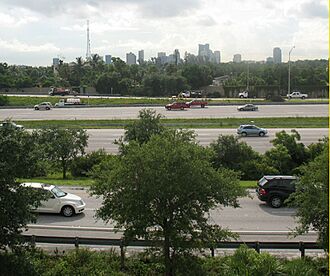

Fort Lauderdale–Hollywood International Airport is the city's main airport. It is one of the fastest-growing major airports in the country. This is partly because many low-cost airlines use it. This makes flights cheaper than at Miami International Airport.
Fort Lauderdale-Hollywood is also becoming an important airport for flights to the Caribbean and Latin America. Miami International Airport and Palm Beach International Airport also serve the city.
Water Travel
Fort Lauderdale is home to Port Everglades. This is the third busiest cruise port in the United States. It is also Florida's deepest port and an important place for receiving oil. Fort Lauderdale has a regular international ferry service to Freeport, Grand Bahama Island, in the Bahamas. This service is run by Baleària Caribbean.
Roads
Broward County has three major interstate highways: I-75, I-95, and I-595. It also has U.S. Highways like U.S. 1, US 27, and US 441. Florida's Turnpike and State Highway 869 (the Sawgrass Expressway) also serve the area.
Healthcare
Fort Lauderdale has several hospitals. These include Broward General Medical Center and Imperial Point Medical Center. They are part of Broward Health, one of the largest hospital groups in the U.S. Broward General is a large hospital with 716 beds. It is a major trauma center. It also has a children's hospital and a heart center. This hospital is a training site for medical students and nursing programs.
Imperial Point Medical Center has 204 beds and offers special medical treatments. Holy Cross Hospital is another large hospital with 571 beds. It was named one of the 50 best hospitals in the country in 2007.
Sister Cities
Fort Lauderdale has "sister city" relationships with many cities around the world. These partnerships help promote cultural and economic ties.
 Agogo, Ghana
Agogo, Ghana Belo Horizonte, Brazil
Belo Horizonte, Brazil Cap-Haïtien, Haiti
Cap-Haïtien, Haiti Duisburg, Germany
Duisburg, Germany Gold Coast, Australia
Gold Coast, Australia Haifa, Israel
Haifa, Israel Kaohsiung, Taiwan
Kaohsiung, Taiwan Mar del Plata, Argentina
Mar del Plata, Argentina Margarita Island, Venezuela
Margarita Island, Venezuela Mataró, Spain
Mataró, Spain Medellín, Colombia
Medellín, Colombia Muğla, Turkey
Muğla, Turkey Panama City, Panama
Panama City, Panama Quepos, Costa Rica
Quepos, Costa Rica Rimini, Italy
Rimini, Italy La Romana, Dominican Republic
La Romana, Dominican Republic São Sebastião, Brazil
São Sebastião, Brazil
See also
In Spanish: Fort Lauderdale para niños


